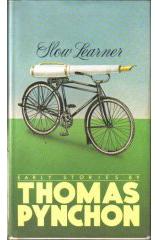The Thomas Pynchon Countdown: Slow Learner
W-wait a minute...Slow Learner? I thought we only had one book left. I thought it was called Mason & Dixon. A-and I thought the Pynchon Countdown happened on Mondays, not Saturdays. What...who are you? What's your message? What do you want?
Well, I wasn't originally going to review Slow Learner. The reasons why should become clear below. But it fits nicely into my pre-late-afternoon plans and there's really no reason I have to skip it...so here goes.
 Slow Learner was published in 1984. It is a collection of Thomas Pynchon's first five published stories. (I am only aware of the existence of six published stories, so this is just about comprehensive.) Four of these stories were written before any of his novels, and the fifth was written and published between V. and The Crying of Lot 49.
Slow Learner was published in 1984. It is a collection of Thomas Pynchon's first five published stories. (I am only aware of the existence of six published stories, so this is just about comprehensive.) Four of these stories were written before any of his novels, and the fifth was written and published between V. and The Crying of Lot 49.
But let's not get held up talking about the stories. Because even though this is a story collection, its real value comes from the introduction.
Yes, as far as I am concerned, Slow Learner is only about 25 pages long, with 125 pages worth of background information (the stories themselves) tacked onto the end.
The introduction is--rightfully--cherished by Pynchon fans, because it's really the only time he's ever officially talked about himself. And about his writing. The man never gives interviews, he never talks to the press, he never meets his readers. Almost everything we know about the man is down to conjecture and speculation. And even though his introduction doesn't exactly throw light over his mysterious form, it is the only time he's opened the blinds and allowed us that small little peek inside.
Also, it must be said, the introduction is fantastic. He speaks more about his influences than about himself, but he does address each of the five stories individually, judging them very harshly (one expects the title Slow Learner was not meant ironically), and explaining why, exactly, they didn't work.
I've heard of this book being used as a text in creative writing courses, and I don't think it's a bad idea for any budding author to read this book. I would, however, advise people not to read this book for entertainment, but to read it for instruction. This is as close to Thomas Pynchon Teaches Fiction as we're ever going to get.
While I do feel he is slightly too hard on himself, it's much more refreshing than if he were slightly too easy. The introduction was penned shortly after Pynchon himself re-read the stories for the first time in decades, and he's able to see them for what they were: the writings of a young man, much too self-assured, too stubborn to find his own footing. (I personally feel that the same charge can be levelled--less severely--at V.)
The introduction is almost Pynchon's evaluation of an unrelated author, an up-and-comer who is trying to ape the success of Thomas Pynchon. And it's evident that he has mixed feelings about just how far behind this Pynchon-out-of-the-past really is:
I mean I can't very well just 86 this guy from my life. On the other hand, if through some as yet undeveloped technology I were to run into him today, how comfortable would I feel about lending him money, or for that matter even stepping down the street to have a beer and talk over old times?
I don't know how many of you out there write, but those who do, who have stumbled upon some years-old printout or abandoned text file of yours, will understand fully what he means by that.
The stories, by and large, are unimpressive. They aren't bad...but they are unimpressive. They do sort of show off the sort of things Pynchon would later achieve...but not many of them. The characters are flat, the plots forced, the "realizations" too specifically explained to be anything other than factual. All of this is acknowledged in the introduction, which is disarming in its honesty.
For a Pynchon fan, though, the stories will be required reading for one reason or another. Under the Rose was later reworked and appeared as a chapter in V. Low-lands features the debut of Pig Bodine (who later appeared in V., Gravity's Rainbow and--sort of--Mason & Dixon), and The Secret Integration sees a very young Hogan Slothrop, who is mentioned in Gravity's Rainbow as the older brother of Tyrone Slothrop.
But it's difficult to recommend this book. To somebody who is already a fan of Pynchon's work and an amateur fictionist, yes, it's essential, and tremendously instructional. But to somebody looking to discover a great author...well...that's what his novels are for. Steer clear of this one.
About this entry
- By Phil Reed
- Posted on Saturday, November 18 2006 @ 5:17 pm
- Categorised in Books, Review
- Tagged with thomas pynchon, slow learner, thomas pynchon countdown
- 1 comment

Oh wow...I'd forgotten about the short story collection. I'm going to have to check this out. Thomas Pynchon Teaches Fiction sounds very interesting.
I've just stumbled across an old file of mine that has plenty of old material. And it is all awful. Ross-out-of-the-past was a pretentious moron who was obviously in the midst of a literary infatuation with Ellison and Silverberg and all the other New Wave writers. I wouldn't lend him money, and I wouldn't have a beer and talk about old times. I'd probably kick him in the forehead.
By Austin Ross
November 19, 2006 @ 2:45 am
reply / #